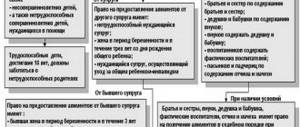The penalty is usually found in civil contracts, when collecting credit or other debt. This sanction is a kind of compensation that can be received for late payments and other obligations. It is also possible to collect a penalty in alimony relations if the debtor, without good reason, stops paying money for the child. Read in this material what the calculation of alimony penalties is in legal and simple language, how you can calculate it, and whether the law allows you to change the size of the sanction.
What is a penalty for alimony?
From a legal point of view, a penalty is a sum of money paid by the debtor to the creditor in the event of non-fulfillment or improper fulfillment of obligations. This wording is specified in Art. 330 Civil Code of the Russian Federation.
Collection of the penalty is carried out voluntarily, when the debtor does not deny his guilt. In this case, he can independently transfer the money to the other party in order to avoid litigation.
To avoid troubles, it is recommended to keep bank receipts so that if problems arise, you will be able to confirm the voluntary fulfillment of obligations in court. If payment is made in cash, it is necessary to obtain a receipt from the claimant.
There is another way to claim penalties - through the court. The initiator is the party receiving the service, in the case of alimony - money. When it comes to collecting penalties for child support payments, the plaintiffs are usually women, since they are the ones who remain with minors.
Grounds and conditions for collecting penalties
The main condition for collecting a penalty is that the alimony payment is late by at least 1 day. The deadlines for paying money for the maintenance of minors are indicated in writs of execution (IL), alimony agreements or court orders.
For example, payments should have been received on January 12, 2018, but the claimant received them on January 15, 2018; for the specified period, he has the right to claim a penalty.
Other recovery conditions:
- Established child support obligations. The debtor must pay alimony by agreement, IL or court order. If the recipient has not previously gone to court or has not drawn up an agreement with the payer at the notary, it is not a penalty that is collected, but alimony for the past period - a maximum of 3 years preceding the date of filing the claim with the court.
- Existence of debt. It begins to form on the day following the day when the payment was supposed to arrive.
Important! The law allows for alimony agreements to be drawn up between spouses or former spouses. They must think through its content independently, focusing on the provisions of Chapter. 16 IC RF. When the document does not indicate that a penalty will be collected if there is a delay, it is problematic to obtain it even in court.
Specific terms and amounts of alimony debt for going to court are not established by law. A claim can be filed even after a week, but the amount of payments will be minimal - no more than 500 rubles. depending on the amount of alimony.
It is recommended to file a claim after 5-6 months from the date of non-payment: in this case, it will be possible to withhold a large amount from the payer. In some cases, it exceeds the amount of the principal debt.
Complete the survey and a lawyer will share a plan of action for alimony in your case for free.
You might find it useful:
Child support calculator
Penalty calculator
Samples of documents on alimony
Legal advice on alimony
Algorithm for further actions
Having received the calculations, it is not at all necessary to immediately go to court . It is recommended to present them to the payer with an explanation that delays in transferring alimony will only lead to an increase in the amount of the penalty.
General information on drawing up an application for a penalty is described in a special material. Recommended reading.
For clarity, another calculation is carried out, which clearly shows what will happen if the payer delays payments for another month. Continuing the previous calculations, we obtain the debt for May 2021, in which the amount of the penalty is:
- On February 1 - 14 tr. × 122 × 0.5/100 = 8.54 tr.;
- On March 1 - 16 tr. × 89 × 0.5/100 = 7.12 tr.;
- On April 1 - 16 tr. × 61 × 0.5/100 = 4.88 tr.;
- On May 1 - 16 tr.x30x0.5/100=2.40 tr.
The total value of the penalty is 8.54 + 7.12 + 4.88 + 2.4 = 22.94 tr. The total amount of the claim will be 14+16+16+16+22.94=84.94 tr. But what matters is the increase by 9.44 tr. amount of penalty. If another month passes, then on June 1, 2021, the following number of days of delay will be taken for calculations:
- For January – 31+28+31+30+31=151 days;
- For February – 28+31+30+31=120 days;
- For March – 31+30+31=92 days;
- For April – 30+31=61 days;
- For May – 31 days.
Thus, the penalty for each month will be:
- On February 1 - 14 tr. × 151 × 0.5/100 = 10.57 tr.;
- On March 1 - 16 tr. × 120 × 0.5/100 = 9.6 tr.;
- On April 1 - 16 tr. × 92 × 0.5/100 = 7.36 tr.;
- On May 1 - 16 tr. × 61 × 0.5/100 = 4.88 tr.;
- As of June 1 - 16 tr. × 31 × 0.5/100 = 2.48 tr.
The total amount of the penalty is 10.57 + 9.6 + 7.36 + 4.88 + 2.48 = 34.89 rubles. As a result, it turns out that the penalty is:
- On April 1 - 13.5 tr;
- On May 1 – 22.94 tr;
- As of June 1 – 34.89 tr.
The difference between penalties for May and June is 11.95 tr., and for April and June – 21.39 tr. That is, it increases with every month of debt. This is a compelling argument to force the payer to pay within a short time frame.
What's next?
Having received the calculations in hand, you must:
- Send a letter to the alimony payer.
- Establish all his places of work.
- Send them a request regarding the period of employment of the payer and salary.
The obtained query results are analyzed to identify the fact of concealment of salary data. To establish the actual employment of the debtor, it is necessary to send a written request to state funds - pension and social insurance. Another official appeal is to the tax service.
The letter indicates the reason for the appeal - arrears of alimony. In addition, a court decision or agreement between the spouses is attached, which determined the procedure and amount of payments. Additionally, requests are sent to banking institutions regarding the issue of a loan by the payer, indicating his place of work and the amount of wages.
Such requests may be ignored; the response to them will be formal and concerns the protection of personal data. Therefore, it is recommended to initiate appeals through bailiffs.
In some cases, it is useful to analyze state register data . It records transactions for the purchase and sale of real estate, enterprises, etc. The data obtained may indicate the payer’s real income, which allows him to make expensive purchases.
After such careful preliminary work, the alimony recipient ends up with factual data indicating the payer’s dishonesty. In this case, alimony and penalties are recalculated; the amount of the claim can be hundreds of thousands of rubles or more.
Once the materials are in hand, you can conduct additional negotiations with the debtor . If they are unsuccessful, a claim is drawn up, which is sent along with additional documents to the court.
Read more about judicial practice on the collection of penalties here.
Amount of penalty for alimony
In 2021, Federal Law No. 224 came into force, according to which, by order of the President of the Russian Federation, the amount of the penalty was reduced from 0.5 to 0.1% of the debt amount for each day of delay. These changes are beneficial to debtors, but not beneficial to recipients.
The reason for the publication of the law was the accrual of huge alimony debts, which cannot be collected due to the expiration of the statute of limitations, the payers lack of official work or property ownership.
Thanks to the Federal Law, those obligated for alimony have the opportunity to be released from the obligation to pay the penalty in whole or in part, if it is proven that the debt was not caused by their fault and they have valid reasons that do not allow them to pay off the debt.
Reducing the amount of the penalty
There are two ways to apply for a reduction in the amount of the penalty or exemption from its payment - by filing an objection to the claim or a counterclaim. This is possible if there are grounds specified in Art. 114 RF IC:
- lack of guilt;
- valid reasons for non-payment.
Good reasons should be understood as factors for which payments were not made regardless of the payer’s wishes: conscription for military service, long-term treatment for a serious illness, etc.
Collection of alimony debt after 18 years: procedure and deadlines
How to reduce the amount of alimony penalties?
How is it paid?
The penalty is paid by court decision or on the basis of an agreement concluded between the parents.
To receive payment of alimony penalties, you must obtain a writ of execution and present it to the FSSP for collection.
If for some reason the recipient does not apply for collection, then no payment is made.
Important! The fact of receiving a decision does not entail the actual transfer of money. If the payer has no source of income and property, the actual transfer of the penalty may be delayed indefinitely.
Calculation of penalties for alimony
If alimony is ordered by the court and the writ of execution is submitted to the FSSP, the claimant must apply to the bailiff for a ruling on the calculation of the debt.
The calculation itself is carried out as follows:
- The number of days of delay is determined.
- The payer's earnings for the above period are established. When this is not possible, the calculation is based on the average earnings in the country. The absence of an official place of work is not grounds for exemption from payment.
- The amount of the principal debt is summed up and then multiplied by 0.1%. The result obtained reflects the amount of the penalty for 1 day of delay.
- The amount of the penalty for 1 day is multiplied by the number of days of non-payment.
When collecting a penalty for late alimony in a fixed amount of money, the calculation is carried out taking into account the indexation performed.
Important! In addition to the penalty and the principal debt, the defaulter is charged an enforcement fee of 7% for each debt (Article 112 of Federal Law No. 229).
Alimony penalty calculator
Calculator from Dogovor-Yurist.Ru
An example of calculating alimony penalties as a share of salary
Yudin S.V. is obliged to pay alimony for one child according to the writ of execution, the amount of payments is 25% of the salary. The average salary of a payer is 30,000 rubles. There was a delay in alimony obligations of 953 days.
30,000 x 25% = 7,500 rub. payable monthly.
7500 x 32 (months) = 240,000 rubles. – the total amount of alimony debt for the period of delay.
240,000 x 0.1% = 240 rubles. – penalty for 1 day of non-payment.
240 x 953 = 228,720 rub. – penalty for the entire period.
228,720 + 240,000 = 468,720 rubles. – the total amount of debt.
An example of calculating alimony penalties in a fixed amount
Musov O.P. was ordered to pay alimony for the maintenance of two children, the amount is 17,000 rubles. monthly. He was 91 days overdue on his payment.
17,000 x 3 (months of non-payment) = 51,000 rubles. – total amount of debt.
51,000 x 0.1% = 51 rub. – penalties for 1 day of non-payment.
51 x 91 = 4,641 rub. – the total amount of the penalty.
51,000 + 4,641 = 55,641 rubles. – the total amount of debt.
For comparison, consider an example where the calculation is carried out at the old rate - 0.5% of the debt amount. The conditions are similar.
51,000 x 0.5% = 255 rubles. – penalty for delay of one day.
255 x 91 = 23,205 rub. – the amount of the penalty.
23,205 + 51,000 = 74,205 rubles. – total payable (principal debt + penalty).
As can be seen from the example, reducing the amount of the penalty at the legislative level allowed debtors to avoid more significant penalties.
Are you tired of reading? We’ll tell you over the phone and answer your questions.
How to calculate penalties in a fixed monetary amount
The simplicity of calculating the penalty when collecting alimony in TDS lies in the fact that every month the debt increases by the same amount.
Suppose the father must pay 7,000 rubles per month for the child and has not transferred funds for 5 months. You can calculate the penalty as follows:
| № | Month | Number of days | Amount of debt, rub. | Percent | Penalty, rub. |
| 1 | March | 31 | 7000 | 0,1% | 217 |
| 2 | April | 30 | 14000 | 0,1% | 420 |
| 3 | May | 31 | 21000 | 0,1% | 651 |
| 4 | June | 30 | 28000 | 0,1% | 840 |
| 5 | July | 31 | 35000 | 0,1% | 1085 |
| Total: | 3213 | ||||
For example, in this case, to find out the amount of debt in April, you need to multiply 7,000 by 2, since April is the second month of debt, and in May, you need to multiply 7,000 by 3, and so on.
The order of collection of penalties for alimony
The legislation contains the concept of “priority of payments”, meaning the degree of importance of various contributions of citizens withheld in the presence of several obligations. Alimony is a priority payment.
The same applies to the penalty, but it will be withheld secondarily after the main alimony debt has been claimed. Here you need to take into account Art. 99 Federal Law No. 229, where the total amount of deductions under the executive document cannot exceed 50%.
For example, if alimony is 25%, the remaining 25% may be withheld to pay off the debt. When collecting payments for three children in the amount of 50%, it is allowed to increase the established threshold to 70%, and then 50% will be collected to cover the principal debt, and the remaining 20% will be a penalty.
Alimony and penalties for it, compensation for harm to health, compensation for moral damage are in first place in order of priority. These are followed by other payments:
- collection of royalties, severance pay;
- taxes and other government fees;
- claims of creditors and other payments.
The order of priority should be followed by the organization at the place of employment of payers, as well as by banks, if citizens’ earnings pass through them. If there are insufficient funds in the account, alimony is transferred first, and then the remaining contributions.
The corresponding note on the mandatory transfer of money for the maintenance of minors is placed in the payment order submitted by accountants to financial institutions.
Collection of penalties for alimony
The step-by-step collection procedure looks like this:
- The claimant submits an application for execution of a decree on debt settlement to the bailiff who opened enforcement proceedings (IP) initially after presentation of the IL.
- The bailiff issues the order within 10 calendar days. You must receive it in person, or when applying, indicate delivery by Russian Post in your application.
- A statement of claim is drawn up, then, with the accompanying documentation, it is submitted to the magistrate’s court at the place of residence of the defendant or plaintiff.
- The judge initiates proceedings within 5 days, and the parties are notified of the date of the first court hearing. The defendant is sent a notice along with a copy of the claim.
- The case is being prepared for trial.
- A hearing is being held. As a result, a decision is made on partial or full satisfaction of the claims or refusal to satisfy them.
Important! If the court decision does not suit the plaintiff or defendant, before it enters into legal force, they can appeal it to the appellate instance. After this, an appeal is made by filing a cassation appeal.
Jurisdiction
According to the Resolution of the Plenum of the Armed Forces of the Russian Federation dated December 26, 207, a claim for the recovery of alimony penalties is filed in the magistrate’s court at the registered address of the defendant or plaintiff.
The specific judicial body is determined by the plaintiff.
Application for calculation of alimony debt
The application form can be downloaded on the website of the regional division of the FSSP or on our website.
To fill out you will need the following information:
- name of the FSSP;
- Full name, address and telephone number of the claimant;
- date and number of the IL issued earlier;
- Full name of the bailiff;
- Full name, place of registration of the debtor and the child for whom alimony was collected;
- the date of the last payments made to those liable for alimony;
- the specific period for which it is necessary to determine the amount of debt;
- request to determine the amount of debt;
- date of compilation and signature;
- list of attached documentation.
Sample statement of claim:
Consultation on document preparation
After submitting the application, the claimant is given a notice indicating the deadline for the resolution to be ready. Subsequently, it is sent to the debtor at the initiative of the bailiff.
Contents of the statement of claim
Samples of statements of claim are not established for citizens, but when filing, it is important to comply with the content requirements.
The claim includes the following information:
- name of the judicial authority;
- Full name, registration addresses of the plaintiff and defendant;
- information from the IL issued earlier;
- period of non-payment of alimony;
- on what basis were payments collected for the child (court order, IL, agreement, etc.);
- the amount of debt on alimony payments;
- the amount of the penalty;
- information about the child;
- number of the resolution on debt settlement;
- a list of attached documents;
- demand for collection of debt and penalties for alimony;
- number and signature.
Sample and form of claim
In the requirements section, the payment of the enforcement fee is not indicated - its collection is within the competence of the bailiffs.
List of attached documents
When filing a claim in court, you will need documentation confirming the validity of the claims:
- resolution on debt settlement;
- the plaintiff's passport and the child's birth certificate. If there are several children, certificates of all are provided;
- IL, order or agreement on the basis of which alimony is collected.
Upon acceptance, copies are made of documents and the originals are given to the owner.
State duty amount
In accordance with current legislation, plaintiffs wishing to collect alimony or penalties for it are exempt from paying state duty. Subsequently, it is recovered from the defendants. For one child you will have to pay 150 rubles.
Arbitrage practice
In cases of recovery of penalties, judicial practice is ambiguous. In most cases, the courts accept the position of the plaintiffs, but when drawing up a decision, they are guided not only by the interests of the children, but also by the justification of the claims, as well as the financial situation of the parties.
During the preparation of the case for proceedings, the defendant may file an objection with a request to reduce the amount of the penalty or to exempt it from payment completely. This is possible if there are legal grounds. Partial exemption is also permitted.
Limitation period for collecting alimony penalties
The penalty is collected at any time, even if at the time of filing the claim the child for whom alimony was paid was 18 years old. The general statute of limitations under the Civil Code of the Russian Federation is 3 years, but this does not apply to the collection of payments for children and penalties for them.
What it looks like in practice:
According to the IL, the man was obliged to transfer money for the maintenance of one child in June 2012. The amount of alimony is 10,000 rubles. the last payment was received in January 2015, and in August 2021 the payer’s son turned 18 years old, which is the basis for exemption from child support obligations.
In February 2021, the woman went to court to recover penalties for 36 months.
The principal debt is accrued for the period from February 2015 to July and part of August 2021, and the penalty is calculated from the moment of the last payment until the date of execution of the settlement order. Number of days – 1096. How everything is calculated:
10,000 x 16 (months of non-payment) = 160,000 rubles. - main debt.
160,000 x 0.1% = 160 rubles. – penalty for the day of non-payment.
160 x 1096 = 175,360 rub. – penalty in general.
175,360 + 160,000 = 335,360 rub. – total payment.
Learn more about the statute of limitations for collecting alimony penalties.
Responsibility for non-payment of penalties
The alimony recipient may demand not only payment of a penalty, but also compensation for losses incurred due to lack of timely payments. To do this, it is necessary to present evidence and demand compensation through the court.
Example . You can submit a check for prepayment of clothes or equipment for a child, the purchase of which did not take place due to a violation of child support obligations. You can also recover additional costs incurred for travel to court, the FSSP department, if such actions are associated with significant costs.
Otherwise, the defaulter of alimony penalties is subject to the same standards of liability as malicious evasion of child support.
- Art. 5.35.1 Code of Administrative Offenses of the Russian Federation - for prosecution for the first detected fact of malicious evasion;
- Art. 157 of the Criminal Code of the Russian Federation - for prosecution after the commission of an administrative offense and ongoing violation of the rights of the child.
Attention! A fine for non-payment may be imposed even if the defendant does not have a permanent job.
In this case, the following may be applied to the debtor:
- recovery from property;
- ban on leaving the country;
- restriction on the right to drive a vehicle.
Lawyer's answers to questions about collecting penalties
How is the penalty collected if the debt is paid gradually?
If the bailiff's order has already been drawn up, the penalty is collected in the amount determined from the debt specified in it, even if after filing the claim the debtor began to pay it.
When a new debt is formed, another resolution is drawn up, and it is collected under a separate IL.
If the alimony obligee pays part of the assigned alimony, he also develops a debt for the actually unpaid part. For example, when depositing 5,000 rubles. from the established amount of 12,000 rubles. the penalty will be charged at 7,000 rubles.
Is it possible to collect a penalty if the alimony debt is fully repaid?
If the debt is repaid before the creditor goes to court, there is an opportunity to claim a penalty. To do this, it is enough to contact the bailiff for a ruling, then file a statement of claim. Voluntary repayment of a debt does not exempt you from paying a penalty.
Is it possible to claim a penalty if the child is already 18 years old?
Once a child reaches the age of majority, a fine can be collected at any time. Statutes of limitation do not apply.
Is a penalty collected if the debtor does not work?
Lack of employment does not exempt from alimony obligations, and penalties are collected according to the algorithm presented above. However, in this case, the average earnings in the country are used for calculation, since it is not possible to determine the payer’s income.
Is a penalty collected if the writ of execution was withdrawn or not presented?
Judicial practice on this issue is ambiguous. According to the Definition of the Armed Forces of the Russian Federation, if the claimant does not present the IL within 3 years or revokes the document, the debt obligations for the debtor are canceled. Motive - to collect a penalty, it is necessary to initiate an individual entrepreneur, and a court decision alone is not enough.
Can the penalty exceed the amount of the principal debt?
Yes maybe. It all depends on the amount of alimony and the duration of the delay. Only deductions from wages are limited - no more than 50, and in some cases - 70%.
Is the payment of a penalty a child support obligation?
Alimony obligations are listed in Chapter. 13 of the RF IC, and the penalty is not included in them. It is a measure of liability for failure to fulfill these obligations.
How is a penalty collected in case of bankruptcy of the payer?
Collection of penalties in case of bankruptcy of the debtor is carried out in accordance with Federal Law No. 229 and Federal Law No. 127-FZ dated December 26, 2002. To repay debt obligations, the property of the defaulter is sold by bailiffs on electronic platforms, the proceeds are divided between creditors and the claimant. First of all, alimony obligations and penalties are paid off.
When they refuse to pay a penalty
Debtors give many reasons for evading alimony payments. The law provides for the possibility of reducing the amount of alimony payments, however, to do this, the payer must submit an application to the court, to which must attach documents confirming the need to reduce the amount of payments.
If the debt has already been calculated, in order to reduce its amount or cancel the penalty, the payer must prove that he has taken steps to resolve this issue. Evidence must also be provided that such actions did not produce a positive result.









